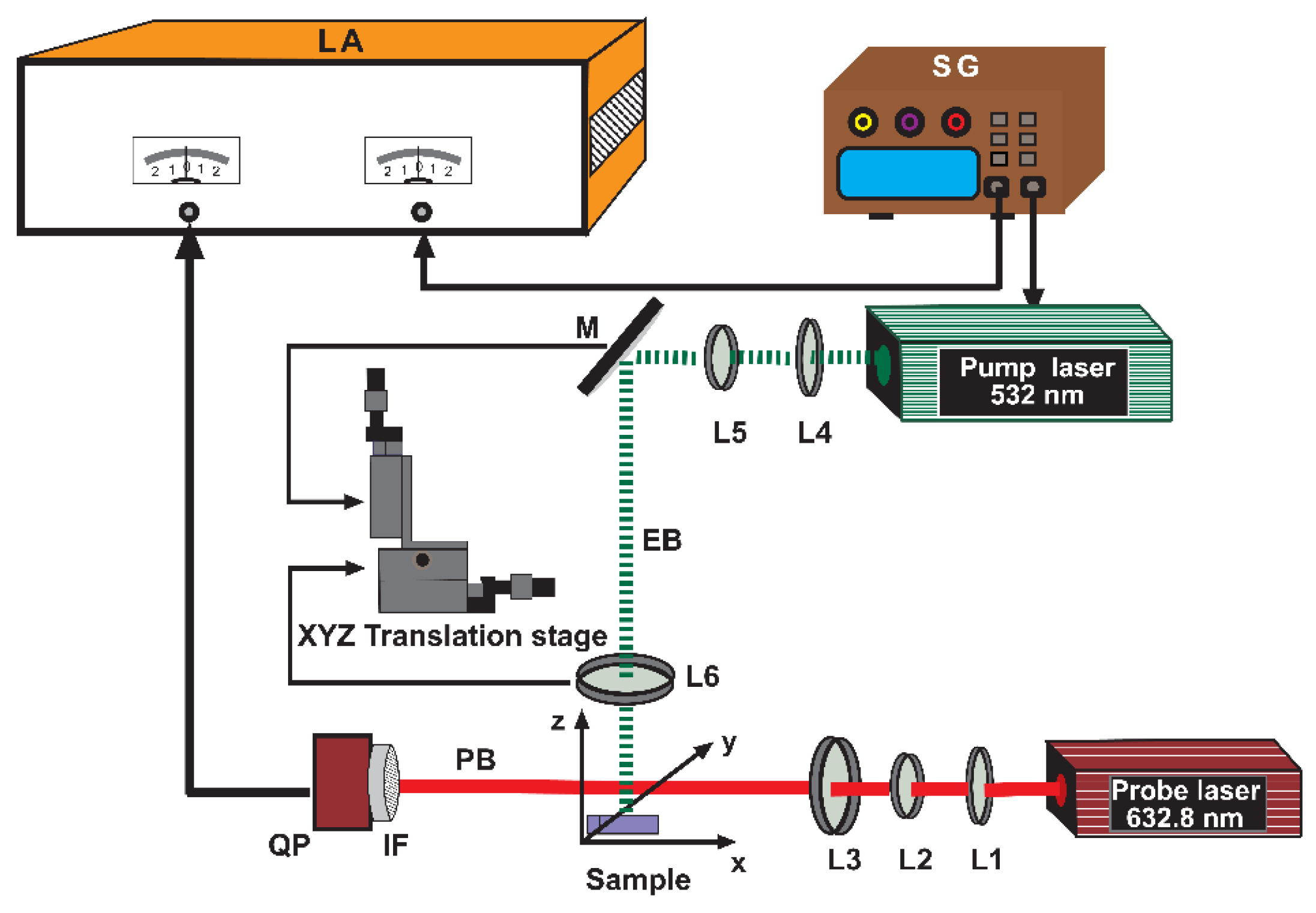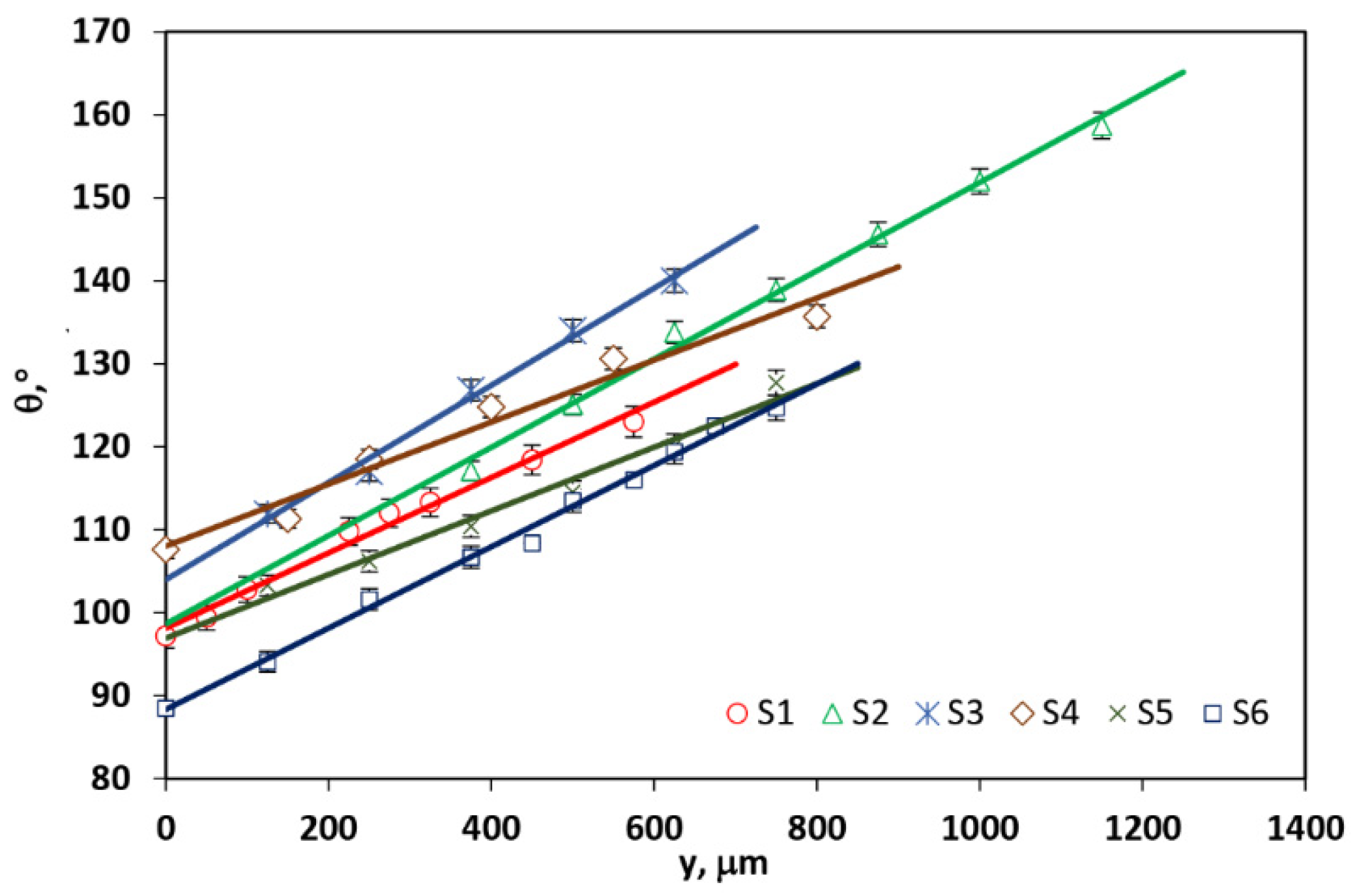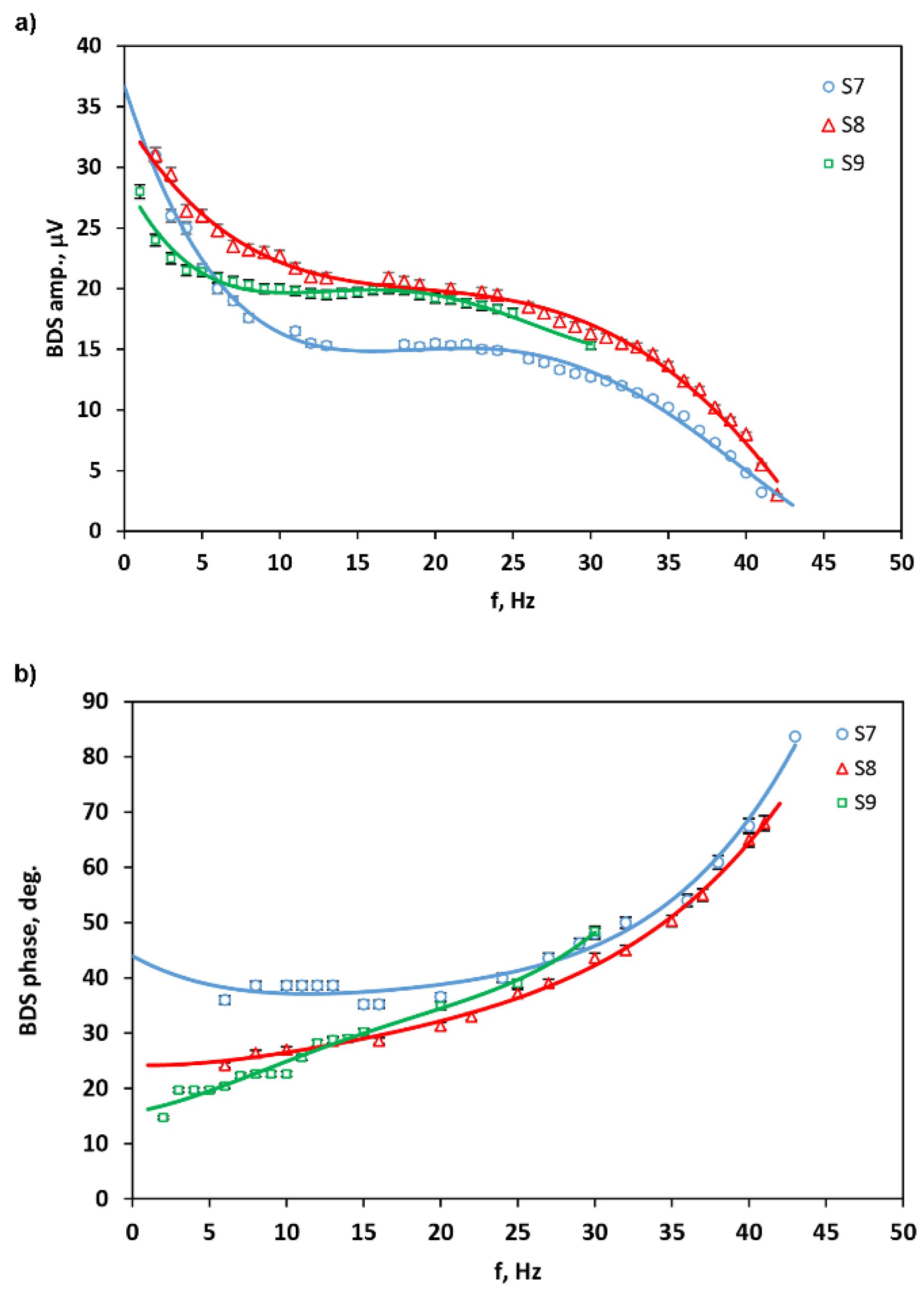Through-Plane and In-Plane Thermal Diffusivity Determination of Graphene Nanoplatelets by Photothermal Beam Deflection Spectrometry
Abstract
1. Introduction
2. Photothermal Beam Deflection Spectrometry Theory
2.1. Surface Scan Method
2.2. Slope Method
2.3. Frequency Scan Method
2.4. Fitting Accuracy
3. Materials and Methods
3.1. Sample Preparation
3.2. Experimental Setup
4. Results and Discussion
4.1. Surface Scan Method
4.2. Slope Method
4.3. Frequency Scan Method
4.4. Comparison of In-Plane and Through-Plane Thermal Properties
4.5. Thermal Conductivity Evaluation
5. Conclusions
Author Contributions
Funding
Institutional Review Board Statement
Informed Consent Statement
Data Availability Statement
Acknowledgments
Conflicts of Interest
Appendix A
Appendix B
Appendix C
Appendix D
References
- Rao, C.N.R.; Sood, A.K.; Subrahmanyam, K.S.; Govindaraj, A. Graphene: The new two-dimensional nanomaterial. Angew. Chem. Int. Ed. 2009, 48, 7752–7777. [Google Scholar] [CrossRef]
- Park, S.; Ruoff, R.S. Chemical methods for the production of graphenes. Nat. Nanotechnol. 2009, 4, 217–224. [Google Scholar] [CrossRef]
- Lee, C.; Wei, X.; Kysar, J.W.; Hone, J. Measurement of the elastic properties and intrinsic strength of monolayer graphene. Science 2008, 321, 385–388. [Google Scholar] [CrossRef]
- Debroy, S.; Sivasubramani, S.; Vaidya, G.; Acharyya, S.G.; Acharyya, A. Temperature and size effect on the electrical properties of monolayer graphene based interconnects for next generation MQCA based nanoelectronics. Sci. Rep. 2020, 10, 6240. [Google Scholar] [CrossRef]
- Balandin, A.A.; Ghosh, S.; Bao, W.; Calizo, I.; Teweldebrhan, D.; Miao, F.; Lau, C.N. Superior thermal conductivity of single-layer graphene. Nano Lett. 2008, 8, 902–907. [Google Scholar] [CrossRef]
- Shen, X.; Wang, Z.; Wu, Y.; Liu, X.; He, Y.-B.; Kim, J.-K. Multilayer graphene enables higher efficiency in improving thermal conductivities of graphene/epoxy composites. Nano Lett. 2016, 16, 3585–3593. [Google Scholar] [CrossRef]
- Cabrera, H.; Mendoza, D.; Benítez, J.; Flores, C.B.; Alvarado, S.; Marín, E. Thermal diffusivity of few-layers graphene measured by an all-optical method. J. Phys. D Appl. Phys. 2015, 48, 465501. [Google Scholar] [CrossRef]
- Lü, K.; Zhao, G.; Wang, X. A brief review of graphene-based material synthesis and its application in environmental pollution management. Chin. Sci. Bull. 2012, 57, 1223–1234. [Google Scholar] [CrossRef]
- Kamedulski, P.; Truszkowski, S.; Lukaszewicz, J.P. Highly Effective Methods of Obtaining N-Doped Graphene by Gamma Irradiation. Materials 2020, 13, 4975. [Google Scholar] [CrossRef]
- Pereira, P.; Ferreira, D.P.; Araújo, J.C.; Ferreira, A.; Fangueiro, R. The Potential of Graphene Nanoplatelets in the Development of Smart and Multifunctional Ecocomposites. Polymers 2020, 12, 2189. [Google Scholar] [CrossRef]
- Rahman, M.M. Low-Cost and Efficient Nickel Nitroprusside/Graphene Nanohybrid Electrocatalysts as Counter Electrodes for Dye-Sensitized Solar Cells. Materials 2021, 14, 6563. [Google Scholar] [CrossRef]
- Potenza, M.; Cataldo, A.; Bovesecchi, G.; Corasaniti, S.; Coppa, P.; Bellucci, S. Graphene nanoplatelets: Thermal diffusivity and thermal conductivity by the flash method. AIP Adv. 2017, 7, 075214. [Google Scholar] [CrossRef]
- Bellucci, S.; Bovesecchi, G.; Cataldo, A.; Coppa, P.; Corasaniti, S.; Potenza, M. Transmittance and reflectance effects during thermal diffusivity measurements of GNP samples with the flash method. Materials 2019, 12, 696. [Google Scholar] [CrossRef]
- Jackson, W.B.; Amer, N.M.; Boccara, A.; Fournier, D. Photothermal deflection spectroscopy and detection. Appl. Opt. 1981, 20, 1333–1344. [Google Scholar] [CrossRef]
- Fontenot, R.S.; Mathur, V.K.; Barkyoumb, J.H. New photothermal deflection technique to discriminate between heating and cooling. J. Quant. Spectrosc. Radiat. Transf. 2018, 204, 1–6. [Google Scholar] [CrossRef]
- Rudnicki, J.D.; McLarnon, F.R.; Cairns, E. In Situ Characterization of Electrode Processes by Photothermal Deflection Spectroscopy. In Thecniques for Characterization of Electrodes and Electrochemical Processes; Varma, R., Selman, J.R., Eds.; Plenum: New York, NY, USA, 1991; pp. 127–166. [Google Scholar]
- Dorywalski, K.; Chrobak, Ł.; Maliński, M. Comparative studies of the optical absorption coefficient spectra in the implanted layers in silicon with the use of nondestructive spectroscopic techniques. Metrol. Meas. Syst. 2020, 27, 323–337. [Google Scholar] [CrossRef]
- Chrobak, Ł.; Maliński, M. On investigations of the optical absorption coefficient of gold and germanium implanted silicon with the use of the non-destructive contactless photo thermal infrared radiometry. J. Electron. Mater. 2019, 48, 5273–5278. [Google Scholar] [CrossRef]
- Pawlak, M.; Kruck, T.; Spitzer, N.; Dziczek, D.; Ludwig, A.; Wieck, A.D. Experimental Validation of Formula for Calculation Thermal Diffusivity in Superlattices Performed Using a Combination of Two Frequency-Domain Methods: Photothermal Infrared Radiometry and Thermoreflectance. Appl. Sci. 2021, 11, 6125. [Google Scholar] [CrossRef]
- Pawlak, M.; Jukam, N.; Kruck, T.; Dziczek, D.; Ludwig, A.; Wieck, A. Measurement of thermal transport properties of selected superlattice and thin films using frequency-domain photothermal infrared radiometry. Measurement 2020, 166, 108226. [Google Scholar] [CrossRef]
- Pawlak, M.; Pal, S.; Scholz, S.; Ludwig, A.; Wieck, A. Simultaneous measurement of thermal conductivity and diffusivity of an undoped Al0. 33Ga0. 67As thin film epitaxially grown on a heavily Zn doped GaAs using spectrally-resolved modulated photothermal infrared radiometry. Thermochim. Acta 2018, 662, 69–74. [Google Scholar] [CrossRef]
- Soumya, S.; Raj, V.; Swapna, M.; Sankararaman, S. Thermal diffusivity downscaling of molybdenum oxide thin film through annealing temperature-induced nano-lamelle formation: A photothermal beam deflection study. Eur. Phys. J. Plus 2021, 136, 187. [Google Scholar] [CrossRef]
- Kim, H.; Kim, J.; Jeon, P.; Yoo, J. The measurement of thermal conductivities using the photothermal deflection method for thin films with varying thickness. J. Mech. Sci. Technol. 2009, 23, 2514–2520. [Google Scholar] [CrossRef]
- Korte, D.; Franko, M. Application of complex geometrical optics to determination of thermal, transport, and optical parameters of thin films by the photothermal beam deflection technique. J. Opt. Soc. Am. A 2015, 32, 61–74. [Google Scholar] [CrossRef]
- Salazar, A.; Sánchez-Lavega, A. Thermal diffusivity measurements using linear relations from photothermal wave experiments. Rev. Sci. Instrum. 1994, 65, 2896–2900. [Google Scholar] [CrossRef]
- Lobemeier, M.L. Linearization Plots: Time for Progress in Regression. HMS Beagle. 2000. Available online: https://nanopdf.com/download/linearization-plots_pdf (accessed on 23 November 2021).
- Korte, D.; Cabrera, H.; Toro, J.; Grima, P.; Leal, C.; Villabona, A.; Franko, M. Optimized frequency dependent photothermal beam deflection spectroscopy. Laser Phys. Lett. 2016, 13, 125701. [Google Scholar] [CrossRef][Green Version]
- Salazar, A.; Sánchez-Lavega, A.; Fernández, J. Thermal diffusivity measurements on solids using collinear mirage detection. J. Appl. Phys. 1993, 74, 1539–1547. [Google Scholar] [CrossRef]
- Sanchez-Lavega, A.; Salazar, A.; Ocariz, A.; Pottier, L.; Gomez, E.; Villar, L.; Macho, E. Thermal diffusivity measurements in porous ceramics by photothermal methods. Appl. Phys. A Mater. Sci. Process. 1997, 65, 15–22. [Google Scholar] [CrossRef]
- Salazar, A.; Sánchez-Lavega, A.; Fernandez, J. Photothermal detection and characterization of a horizontal buried slab by the mirage technique. J. Appl. Phys. 1991, 70, 3031–3037. [Google Scholar] [CrossRef]
- Maliński, M. Investigations and modeling aspects of the influence of the high energy and high dose implantation on the optical and transport parameters of implanted layers in silicon. Phys. B Condens. Matter 2020, 578, 411851. [Google Scholar] [CrossRef]
- Xiang, J.; Drzal, L.T. Thermal conductivity of exfoliated graphite nanoplatelet paper. Carbon 2011, 49, 773–778. [Google Scholar] [CrossRef]






| Sample | P, N | DT-in, ×10−6 m2s−1 | κT-in, W m−1K−1 |
|---|---|---|---|
| S1 | 500 | 46.0 ± 2.2 | 10.2 ± 0.4 |
| S2 | 1000 | 34.4 ± 1.4 | 10.8 ± 0.4 |
| S3 | 2000 | 30.2 ± 0.8 | 13.4 ± 0.6 |
| S4 | 700 | 41.5 ± 1.4 | 11.2 ± 0.6 |
| S5 | 700 | 45.0 ± 1.5 | 12.7 ± 0.7 |
| S6 | 700 | 42.6 ± 1.1 | 11.9 ± 0.8 |
| S10 | 0 | 107.0 ± 2.0 | 24.5 ± 1.8 |
| Sample | a, m−1 | b, ° | R2 |
|---|---|---|---|
| S1 | 0.0454 | 98.13 | 0.9868 |
| S2 | 0.0532 | 98.66 | 0.9943 |
| S3 | 0.0586 | 103.98 | 0.9915 |
| S4 | 0.0374 | 108.03 | 0.968 |
| S5 | 0.0384 | 96.92 | 0.9742 |
| S6 | 0.0490 | 88.33 | 0.9944 |
| Sample | P, N | f, Hz | DT-in, ×10−6 m2s−1 |
|---|---|---|---|
| S1 | 500 | 11 | 50.0 ± 3.2 |
| S2 | 1000 | 11 | 39.2 ± 1.6 |
| S3 | 2000 | 11 | 33.3 ± 1.1 |
| S4 | 700 | 11 | 45.0 ± 1.8 |
| S5 | 700 | 11 | 50.0 ± 2.0 |
| S6 | 700 | 11 | 47.0 ± 1.7 |
| S10 | 0 | 11 | 110 ± 2.4 |
| Sample | P, N | DT-through, ×10−6 m2s−1 | κT-through, W m−1K−1 |
|---|---|---|---|
| S1 | 500 | 14.4 ± 0.2 | 3.23 ± 0.10 |
| S2 | 1000 | 9.30 ± 0.11 | 3.16 ± 0.08 |
| S3 | 2000 | 7.60 ± 0.08 | 3.52 ± 0.12 |
| S4 | 700 | 11.0 ± 0.1 | 3.28 ± 0.14 |
| S5 | 700 | 10.0 ± 0.1 | 3.11 ± 0.12 |
| S6 | 700 | 9.10 ± 0.11 | 2.74 ± 0.10 |
| S7 | 500 | 5.80 ± 0.06 | 1.33 ± 0.06 |
| S8 | 1000 | 6.40 ± 0.08 | 2.25 ± 0.08 |
| S9 | 2000 | 2.10 ± 0.02 | 1.08 ± 0.04 |
| S10 | 0 | 99.5 ± 1.8 |
| Sample | ρ, kg m−3 | κT-in, W m−1K−1 | κT-through, W m−1K−1 |
|---|---|---|---|
| S1 | 300 ± 7 | 11.7 ± 0.6 | 3.07 ± 0.12 |
| S2 | 461 ± 9 | 12.8 ± 0.7 | 3.04 ± 0.10 |
| S3 | 623 ± 18 | 14.7 ± 0.7 | 3.36 ± 0.16 |
| S4 | 398 ± 8 | 12.7 ± 0.6 | 3.11 ± 0.11 |
| S5 | 398 ± 8 | 14.1 ± 0.8 | 2.83 ± 0.09 |
| S6 | 398 ± 8 | 13.3 ± 0.7 | 2.57 ± 0.10 |
| S7 | 300 ± 7 | - | 1.24 ± 0.04 |
| S8 | 461 ± 9 | - | 2.09 ± 0.06 |
| S9 | 623 ± 18 | - | 0.93 ± 0.03 |
Publisher’s Note: MDPI stays neutral with regard to jurisdictional claims in published maps and institutional affiliations. |
© 2021 by the authors. Licensee MDPI, Basel, Switzerland. This article is an open access article distributed under the terms and conditions of the Creative Commons Attribution (CC BY) license (https://creativecommons.org/licenses/by/4.0/).
Share and Cite
Cabrera, H.; Korte, D.; Budasheva, H.; Abbasgholi N. Asbaghi, B.; Bellucci, S. Through-Plane and In-Plane Thermal Diffusivity Determination of Graphene Nanoplatelets by Photothermal Beam Deflection Spectrometry. Materials 2021, 14, 7273. https://doi.org/10.3390/ma14237273
Cabrera H, Korte D, Budasheva H, Abbasgholi N. Asbaghi B, Bellucci S. Through-Plane and In-Plane Thermal Diffusivity Determination of Graphene Nanoplatelets by Photothermal Beam Deflection Spectrometry. Materials. 2021; 14(23):7273. https://doi.org/10.3390/ma14237273
Chicago/Turabian StyleCabrera, Humberto, Dorota Korte, Hanna Budasheva, Behnaz Abbasgholi N. Asbaghi, and Stefano Bellucci. 2021. "Through-Plane and In-Plane Thermal Diffusivity Determination of Graphene Nanoplatelets by Photothermal Beam Deflection Spectrometry" Materials 14, no. 23: 7273. https://doi.org/10.3390/ma14237273
APA StyleCabrera, H., Korte, D., Budasheva, H., Abbasgholi N. Asbaghi, B., & Bellucci, S. (2021). Through-Plane and In-Plane Thermal Diffusivity Determination of Graphene Nanoplatelets by Photothermal Beam Deflection Spectrometry. Materials, 14(23), 7273. https://doi.org/10.3390/ma14237273









